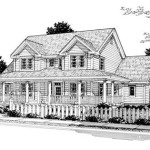House Plans: Colonial Farmhouse
The Colonial Farmhouse style represents a captivating blend of classic architectural elements, combining the stately formality of Colonial design with the rustic charm of a farmhouse. This hybrid style offers homeowners a timeless aesthetic that evokes both historical elegance and comfortable country living. Understanding the defining characteristics of each style helps illuminate the appeal of this increasingly popular architectural choice.
Colonial homes, originating in the 17th and 18th centuries, typically feature symmetrical facades, multi-paned windows, and prominent entryways often adorned with decorative crowns or pilasters. These homes often incorporate classical details borrowed from Greek and Roman architecture, showcasing a sense of order and proportion. Common Colonial sub-styles include Georgian, Dutch Colonial, and Cape Cod, each with its unique nuances, yet all sharing the core characteristics of symmetry and formality.
Farmhouse architecture, on the other hand, prioritizes practicality and functionality. Born from the needs of agricultural life, farmhouses emphasize simple, sturdy construction, often featuring large, open kitchens and ample storage space. Exterior materials traditionally include wood siding, sometimes painted in muted colors or left natural to weather gracefully. Farmhouses often have expansive porches, providing shaded areas for relaxation and socializing, reflecting the importance of community in rural life.
The Colonial Farmhouse style seamlessly merges these distinct traditions, creating homes that balance formal elegance with relaxed livability. Symmetrical facades and multi-paned windows, hallmarks of Colonial design, are combined with farmhouse elements like wide porches, exposed beams, and board-and-batten siding. This fusion creates a unique aesthetic that feels both classic and contemporary.
Choosing a Colonial Farmhouse house plan involves considering several key factors. The desired size and layout of the home are crucial. Some plans emphasize a grand, two-story foyer and formal dining room, reflecting the Colonial influence, while others prioritize a large, open-concept kitchen and family room, characteristic of farmhouse design. Many Colonial Farmhouse plans incorporate both, offering a balance of formal and informal living spaces.
Exterior material choices play a significant role in defining the home's aesthetic. Wood siding, whether clapboard, shingle, or board-and-batten, remains a popular option, often painted in classic white or other neutral shades. Brick or stone accents can further enhance the Colonial aspect of the design. Metal roofs, a common feature of historic farmhouses, are also gaining popularity in contemporary Colonial Farmhouse designs.
Interior design choices further personalize the Colonial Farmhouse style. Flooring options often include wide plank wood floors, contributing to the rustic charm. Exposed beams and shiplap walls can add architectural interest and texture, while fireplaces, both traditional and modern, provide a focal point and enhance the sense of warmth and comfort. Kitchen designs often incorporate farmhouse sinks, shaker-style cabinets, and open shelving, blending functionality with aesthetics.
The versatility of the Colonial Farmhouse style allows for customization and adaptation to individual preferences and regional influences. In warmer climates, large, covered porches and ample outdoor living spaces become essential, while in colder regions, fireplaces and cozy nooks take center stage. The ability to blend seamlessly with various landscapes, from rural settings to suburban neighborhoods, contributes to the enduring popularity of this architectural style.
When exploring Colonial Farmhouse house plans, considering the specific needs and lifestyle of the occupants is essential. The number of bedrooms and bathrooms, the presence of a home office or dedicated playroom, and the inclusion of features like mudrooms or laundry rooms are all important considerations. Analyzing the flow and functionality of the floor plan will ensure the home meets the practical requirements of daily life.
Working with an architect or builder experienced in Colonial Farmhouse design can be invaluable. They can provide guidance on selecting appropriate materials, adapting plans to specific site conditions, and ensuring the finished home reflects the desired aesthetic. Careful consideration of all these elements will result in a Colonial Farmhouse home that is both beautiful and functional, a timeless testament to the enduring appeal of this blended style.
The enduring popularity of the Colonial Farmhouse style stems from its ability to evoke a sense of history and tradition while offering modern amenities and comfort. It’s a style that celebrates both the formal elegance of Colonial architecture and the relaxed practicality of farmhouse design, creating homes that are both inviting and enduring.

House Plan 85454 Farmhouse Style With 3338 Sq Ft 4 Bed 3 Bath

House Plan 59952 Traditional Style With 1870 Sq Ft 3 Bed 2 Ba

Colonial Floor Plan 5 Bedrms Baths 5288 Sq Ft 198 1004

Colonial House Plans Designs Floor Blueprints

Colonial House Plans How To Plan

1923 Colonial House Plans Vintage

House Plan 86342 Southern Style With 3179 Sq Ft 4 Bed 3 Bath

1925 Colonial Revival Classic Home Two Story Bowes Co Hinsdale Il House Plans Beach Mediterranean

Colonial Floor Plan 4 Bedrms 5 Baths 3435 Sq Ft 102 1050

Colonial House Plans Traditional Designs Drummond








